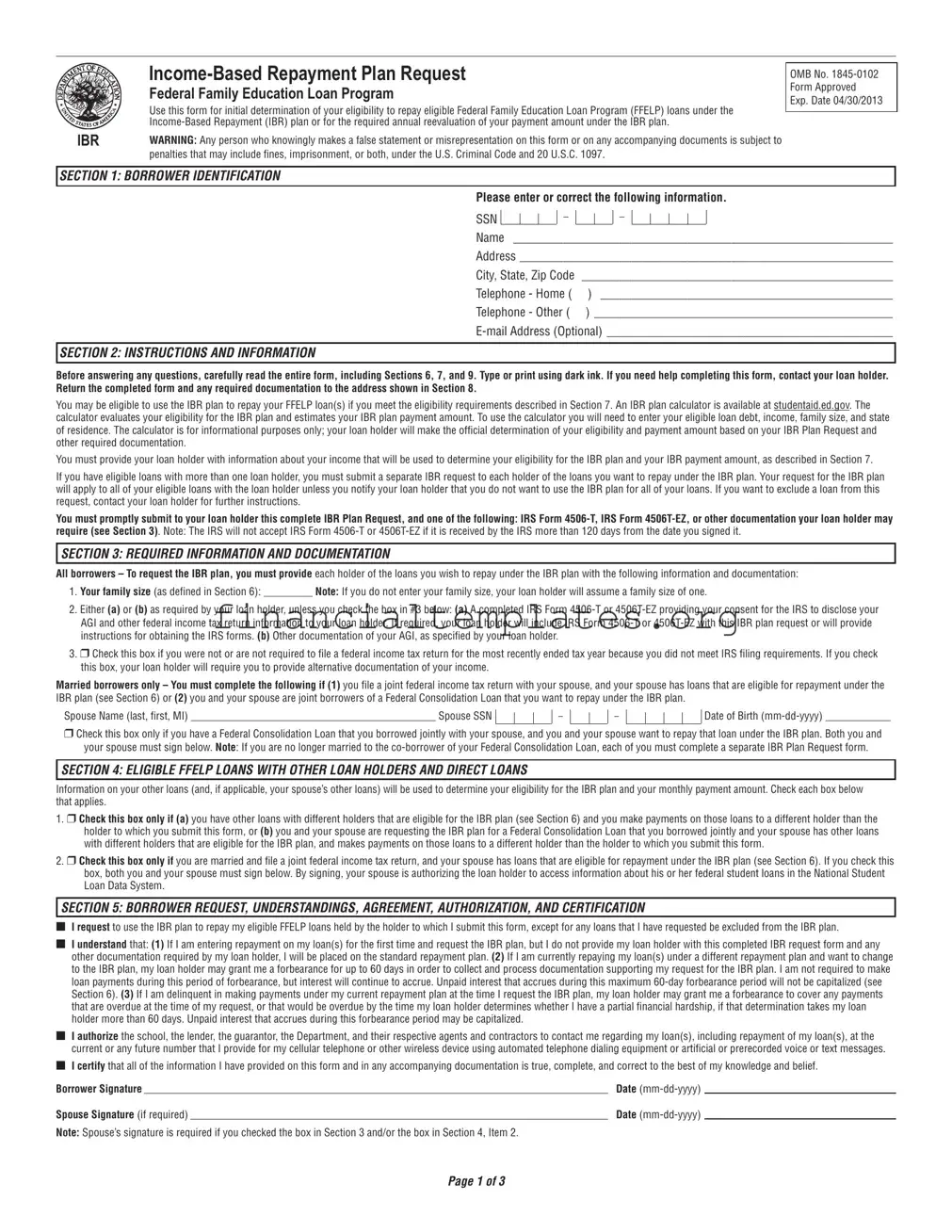SECTION 6: DEFINITIONS
n Capitalization is the addition of unpaid interest to the principal balance of your loan. This will increase the principal balance and the total cost of your loan.
n Eligible loans for the IBR plan are FFELP and Direct Loan Program loans other than: (1) a loan that is in default, (2) a Federal or Direct PLUS Loan made to a parent borrower, or (3) a Federal or Direct Consolidation Loan that repaid a Federal or Direct PLUS Loan made to a parent borrower. Federal Perkins Loans, HEAL loans or other health education loans, and private education loans are not eligible for the IBR plan. To access information on all of your federal student loans, check the National Student Loan Data System at www.nslds.ed.gov.
n Family size includes you, your spouse, and your children (including unborn children who will be born during the year for which you certify your family size), if the children will receive more than half their support from you. It includes other people only if they live with you now, they receive more than half their support from you now, and they will continue to receive this support from you for the year that you certify your family size. Support includes money, gifts, loans, housing, food, clothes, car, medical and dental care, and payment of college costs.
n The Federal Family Education Loan Program (FFELP) includes Federal Stafford Loans (both subsidized and unsubsidized), Federal PLUS Loans, Federal Consolidation Loans, and Federal Supplemental Loans for Students (SLS).
n The holder of your FFELP loan(s) may be a lender or the U.S. Department of Education (the Department). The holder of Direct Loan Program loans is the Department. Your loan holder may use a servicer to handle billing and other communications related to your loan(s). If your loan holder uses a servicer, the term “holder” as used throughout this form may also refer to the servicer.
n Income-Based Repayment (IBR) is a repayment plan with monthly payments based on your eligible federal student loan debt, income, family size, and state of residence.
n Partial inancial hardship is when the annual amount due on all of your eligible loans or, if you are married and ile a joint federal income tax return, the annual amount due on all of your eligible loans and your spouse’s eligible loans, exceeds 15% of the difference between your adjusted gross income (AGI), as shown on your most recently iled federal income tax return, and 150% of the annual poverty guideline amount for your family size and state of residence:
Annual amount of payments due > 15% [AGI – (150% x applicable poverty guideline amount)]
The annual amount of payments due is calculated based on the greater of (1) the total amount owed on eligible loans at the time those loans initially entered repayment or
(2)the total amount owed on eligible loans at the time you or, if applicable, your spouse requested the IBR plan. The annual amount of payments due is calculated using a standard repayment plan with a 10-year repayment period. The amount owed on eligible loans includes the amount owed on your eligible loans and, if you are married and
ile a joint federal income tax return, the amount owed on your spouse’s eligible loans. If you are married and ile a joint federal income tax return, your AGI includes your spouse’s income.
n Poverty guideline amount is the igure for your state and family size from the poverty guidelines published annually by the U.S. Department of Health and Human Services (HHS). The HHS poverty guidelines are used for purposes such as determining eligibility for certain federal beneit programs. If you are not a resident of a state identiied in the poverty guidelines, your poverty guideline amount is the amount used for the 48 contiguous states.
n The William D. Ford Federal Direct Loan (Direct Loan) Program includes Direct Subsidized Loans, Direct Unsubsidized Loans, Direct PLUS Loans, and Direct Consolidation Loans.
SECTION 7: ELIGIBILITY CRITERIA
Important information about the IBR plan includes:
n You may use the IBR plan to repay your eligible FFELP loan(s), as deined in Section 6.
n To initially qualify to repay your loan(s) under the IBR plan and to continue to qualify to make income-based payments, you must have a partial inancial hardship (as deined in Section 6).
n You must submit required information about your income to your loan holder for determination of your eligibility for the IBR plan and your IBR payment amount. You must provide your loan holder with Internal Revenue Service (IRS) Form 4506-T or 4506T-EZ providing your consent for the disclosure of your AGI and other federal income tax return information by the IRS or other documentation of your AGI as required by your loan holder, which may be a copy of your most recently iled federal income tax return. Your loan holder may require you to provide alternative documentation of your income if (1) your AGI is not available from the IRS or your loan holder believes that your AGI does not reasonably relect your current income; (2) you believe that your AGI does not reasonably relect your current income; or (3) you have notiied your loan holder that you were not required to ile a federal income tax return for the most recently ended tax year. Use of alternative documentation of income to determine your IBR eligibility and payment amount is at the discretion of your loan holder.
n When you have a partial inancial hardship, your monthly payment amount under the IBR plan will not exceed 15% of the amount by which your AGI exceeds 150% of the poverty guideline amount for your family size and state of residence, divided by 12:
Monthly payment = 15% [AGI – (150% x applicable poverty guideline amount)] ÷ 12
n After entry into the IBR plan, you must annually certify your family size and provide income documentation for determination of whether you have a partial inancial hardship. Your monthly payment amount for the IBR plan may be adjusted annually. It may be higher or lower, depending on the income documentation and family size information you provide each year. Your loan holder will notify you when you are required to provide this documentation.
n For any year you do not have a partial inancial hardship, your payment amount will be the payment amount for your loan(s) under the standard repayment plan with a 10-year repayment period, based on the amount owed on your eligible loan(s) at the time you initially entered the IBR plan.
n In some circumstances your IBR plan monthly payment amount may not cover all interest that accrues, and your debt may increase. While you are in repayment under IBR, if your monthly payment amount does not cover all interest that accrues each month, the U.S. Department of Education will pay the unpaid interest on your subsidized Stafford loan(s) and on the subsidized portion of your Federal Consolidation Loan(s) for not more than the irst 3 consecutive years after you initially enter the IBR plan. If you receive an economic hardship deferment during this 3-year period, any months of economic hardship deferment will not count toward the 3 consecutive years. The 3-year period will resume when the economic hardship deferment ends.
n Accrued interest is capitalized at the time you choose to leave the IBR plan or no longer have a partial inancial hardship.
n If your loan(s) is not repaid in full after you have made the equivalent of 25 years of qualifying monthly payments and at least 25 years have elapsed, any remaining debt will be eligible for forgiveness. If you receive an economic hardship deferment, any months of economic hardship deferment are considered the equivalent of qualifying payments. Months for which you receive any other type of deferment or months of forbearance are not counted as qualifying payments, and do not count toward the 25-year period.
SECTION 8: WHERE TO SEND THE COMPLETED INCOME-BASED REPAYMENT PLAN REQUEST



